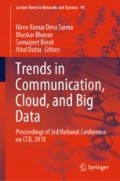Abstract
Landslides are movement of rocks, debris or earth along a slope. There are seven states into which the activities of a landslide can be classified into; they are dormant, relict, suspended, reactivated, active and stabilized. Landslide susceptibility map is very crucial as it provides significant data and information that is required for planning of landslide-prone areas as it provides crucial information about spatial probability regarding the occurrence of landslide which is very important in the planning of land use. This paper provides a review of various studies and experiments conducted in this domain of research. The focus area of the study is Sikkim Himalayan region as it shares some similar type of parameters.
Access this chapter
Tax calculation will be finalised at checkout
Purchases are for personal use only
References
Sujatha ER, Rajamanickam GV, Pichaimani K (2012) Landslide susceptibility analysis using probabilistic certainty factor approach: a case study on Tevankarai stream watershed, India. J Earth Syst Sci. 121. https://doi.org/10.1007/s12040-012-0230-6
Ali Y (2008) GIS-based landslide susceptibility mapping using analytical hierarchy process and bivariate statistics in Ardesen (Turkey): comparisons of results and confirmations. Catena 72:1–12. https://doi.org/10.1016/j.catena.2007.01.003
Brabb EE (1985) Innovative approaches to landslide hazard and risk mapping. In: International landslide symposium proceedings. https://pubs.er.usgs.gov
Vahidnia M, Alesheikh A, Alimohammadi A, Hosseinali F (2009) Landslide hazard zonation using quantitative methods in GIS. IJCE 7(3):176–189. http://ijce.iust.ac.ir/article-1-289-en.html
Korup O, Stolle A (2014) Landslide prediction from machine learning. Geology today, vol 30, no 1. Wiley, The Geologists’ Association & The Geological Society of London
Sharma L, Patel N, Ghose M, Debnath P (2015) Development and application of Shannon’s entropy integrated information value model for landslide susceptibility assessment and zonation in Sikkim Himalayas in India. Nat Hazards 75. https://doi.org/10.1007/s11069-014-1378-y
Sharma LP, Patel N, Ghose MK et al (2013) Synergistic application of fuzzy logic and geo-informatics for landslide vulnerability zonation—a case study in Sikkim Himalayas, India. Appl Geomat 5(4):271–284. https://doi.org/10.1007/s12518-013-0115-
Pradhan B (2011) An assessment of the use of an advanced neural network model with five different training strategies for the preparation of landslide susceptibility maps. J Data Sci 9:65–81
Ahmed B (2014) Landslide susceptibility mapping using multi-criteria evaluation techniques in Chittagong Metropolitan Area, Bangladesh
Chalkias C, Polykretis C, Ferentinou M, Karymbalis E (2016) Integrating expert knowledge with statistical analysis for landslide susceptibility assessment at regional scale. Geosciences 6:14
Kainthura P, Singh V, Gupta S (2015) Gis based model for monitoring and predition of landslide susceptibility. In: 1st International conference on next generation computing technologies (NGCT), pp 584–587. IEEE
Quan HC, Lee BG (2012) GIS-based landslide susceptibility mapping using analytic hierarchy process and artificial neural network in Jeju (Korea). KSCE J Civ Eng 16(7):1258–1266. https://doi.org/10.1007/s12205-012-1242-0
Kayastha P et al (2013) Application of the analytical hierarchy process (AHP) for landslide susceptibility mapping: a case study from the Tinau watershed, west Nepal. Comput Geosci 52:398–408
Dou J et al. (2015) Optimization of causative factors for landslide susceptibility evaluation using remote sensing and GIS data in parts of Niigata, Japan. http://dx.doi.org/10.1371/journal.pone.0133262
Zhang K et al. (2017) The assessment of landslide susceptibility mapping using random forest and decision tree methods in the three gorges reservoir area, China. Springer, Berlin Heidelberg
Author information
Authors and Affiliations
Corresponding author
Editor information
Editors and Affiliations
Rights and permissions
Copyright information
© 2020 Springer Nature Singapore Pte Ltd.
About this paper
Cite this paper
Bhutia, S.L., Borah, S., Pradhan, R. (2020). Landslide Susceptibility Mapping: Development Towards a Machine Learning-Based Model. In: Sarma, H., Bhuyan, B., Borah, S., Dutta, N. (eds) Trends in Communication, Cloud, and Big Data. Lecture Notes in Networks and Systems, vol 99. Springer, Singapore. https://doi.org/10.1007/978-981-15-1624-5_13
Download citation
DOI: https://doi.org/10.1007/978-981-15-1624-5_13
Published:
Publisher Name: Springer, Singapore
Print ISBN: 978-981-15-1623-8
Online ISBN: 978-981-15-1624-5
eBook Packages: EngineeringEngineering (R0)

